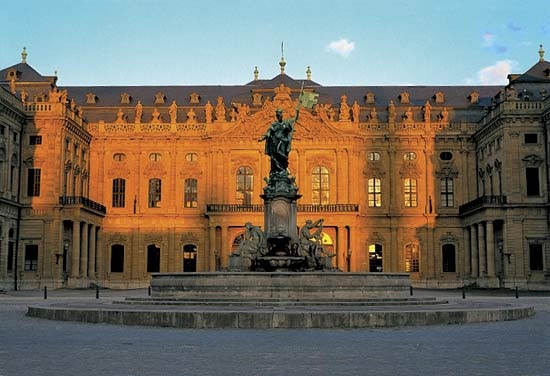Würzburg
Germany
 city, northwestern Bavaria Land (state), south-central Germany. It lies along and is an inland port of the canalized Main River, about 60 miles (100 km) southeast of Frankfurt am Main. The site of a Celtic settlement, it was first mentioned as Virteburch in 704. A bishopric was established there by St. Boniface in the early 740s, and the bishops had acquired ducal authority over eastern Franconia by the 12th century. Repeated revolts against the power of the bishops resulted in the citizens' final submission to their authority in 1400. Several imperial diets (assemblies) and councils were held in Würzburg, including one in 1180, when Henry the Lion was placed under the imperial ban and the Bavarian duchy was taken from him and given to Otto, a member of the Wittelsbach family. Würzburg progressed under Bishop Julius (1573–1617), and much building was commissioned by the bishops of the Schönborn family in the 18th century. The bishopric was secularized in 1802, and the city passed to Bavaria in 1802/03. In 1805 it became the seat of the grand duchy of Würzburg in the Confederation of the Rhine (Rhine, Confederation of the) and remained so until it was restored to Bavaria in 1814. A new bishopric was created in 1821.
city, northwestern Bavaria Land (state), south-central Germany. It lies along and is an inland port of the canalized Main River, about 60 miles (100 km) southeast of Frankfurt am Main. The site of a Celtic settlement, it was first mentioned as Virteburch in 704. A bishopric was established there by St. Boniface in the early 740s, and the bishops had acquired ducal authority over eastern Franconia by the 12th century. Repeated revolts against the power of the bishops resulted in the citizens' final submission to their authority in 1400. Several imperial diets (assemblies) and councils were held in Würzburg, including one in 1180, when Henry the Lion was placed under the imperial ban and the Bavarian duchy was taken from him and given to Otto, a member of the Wittelsbach family. Würzburg progressed under Bishop Julius (1573–1617), and much building was commissioned by the bishops of the Schönborn family in the 18th century. The bishopric was secularized in 1802, and the city passed to Bavaria in 1802/03. In 1805 it became the seat of the grand duchy of Würzburg in the Confederation of the Rhine (Rhine, Confederation of the) and remained so until it was restored to Bavaria in 1814. A new bishopric was created in 1821.Würzburg, once the capital of Franconia, is an administrative capital. It is a centre of grape growing and of rail and river traffic. Also important to the city are the wine trade and the printing industry. Manufactures include medical instruments, pollution-abatement and measurement equipment, electrical goods, clothing, and foodstuffs.
Much of the city was destroyed in World War II, but its postwar reconstruction has been thorough. Although the splendid Baroque episcopal Residenze (built 1719–44 by Balthasar Neumann (Neumann, Balthasar)) was damaged, its grand staircase, with famous frescoes by Giovanni Tiepolo (Tiepolo, Giovanni Battista), survived. The residence and its gardens and square were designated a UNESCO World Heritage site in 1981. Other landmarks include the medieval Main Bridge, the Julius Hospital, the town hall, and the Marienberg fortress, originally a Celtic hill fort, which was the residence of the bishops (c. 1250–1720). The round church within the courtyard of the fortress is one of the oldest churches extant in Germany (706). Würzburg's Romanesque cathedral, begun in 1034, consecrated in 1189, and restored after World War II, recalls the city's former status as the capital of an ecclesiastical principality. Other notable medieval churches include the Marienkapelle, the Neumünster (with a Baroque facade), and St. Burchard's, and among many fine examples of the Baroque and Rococo styles are the Hauger Stiftskirche and the Käpelle, a pilgrimage church (by Neumann). A university was founded at Würzburg in 1403, but it existed for only a few years. The present University of Würzburg (Würzburg, University of) was founded by Bishop Julius in 1582. Pop. (2003 est.) 132,687.
- Delvaux, Paul
- Delvigne, Henri-Gustave
- Delémont
- dema deity
- Demades
- demand curve
- de Man, Paul
- Demaratus
- Demavend, Mount
- Dembiński, Henryk
- deme
- dementia
- Demerara River
- demesne
- Sèvres porcelain
- Sèvres, Treaty of
- séance
- Sébastien Bourdon
- Sébastien Le Nain de Tillemont
- Sébastien Le Prestre de Vauban
- Sébastien-Roch Nicolas Chamfort
- Sébastien Érard
- Ségolène Royal
- Ségou
- Séguier, Pierre